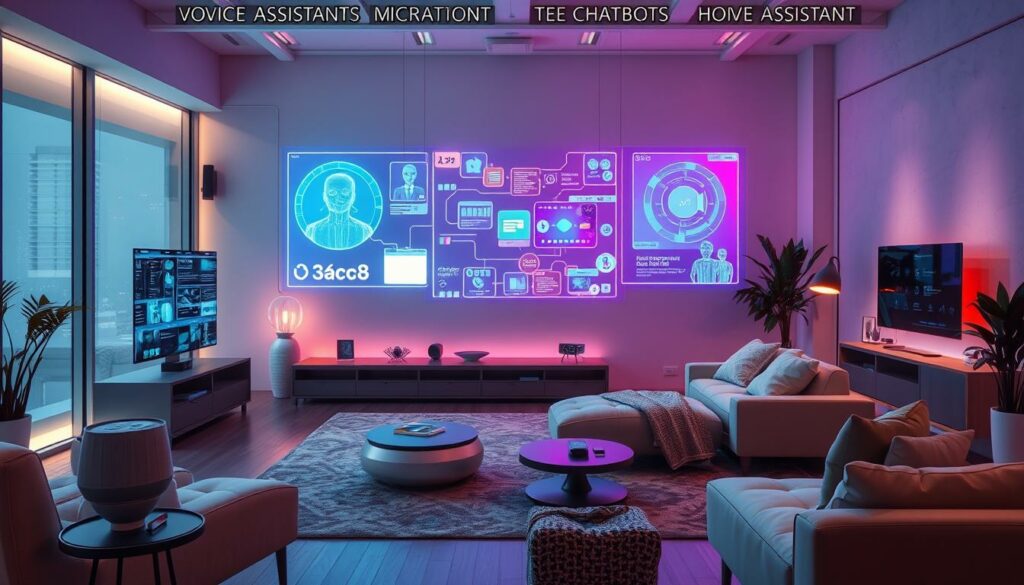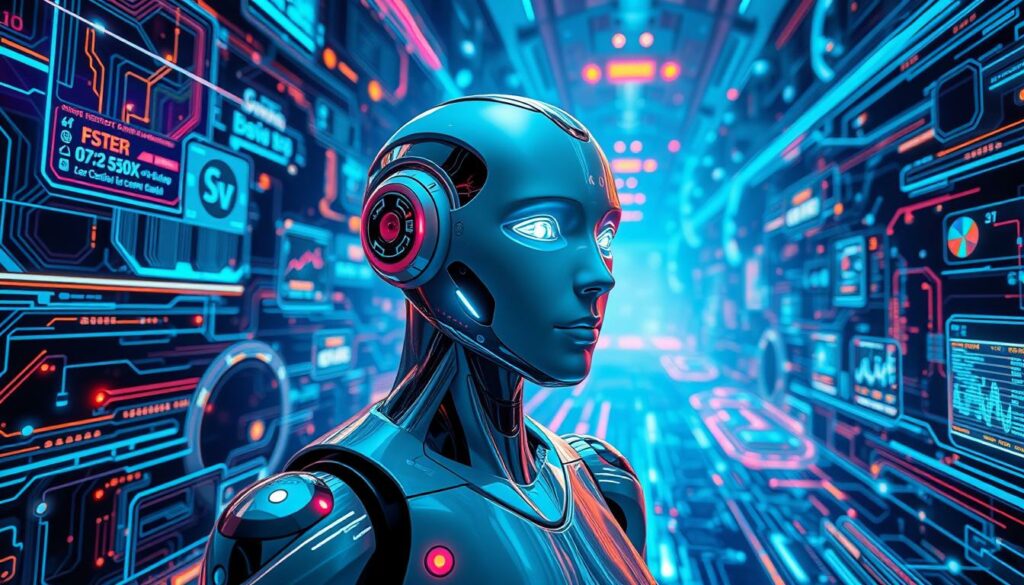In the world of AI Chatbot technology, how companies talk to their customers is changing fast. These clever tools are shaking up digital communication. They’re turning customer service upside down in all kinds of businesses. The arrival of conversational AI starts a new chapter. Now, talking with machines feels smooth, quick, and surprisingly like chatting with a human. By working with voice helpers and making chats more personal, AI chatbots are here to stay. They are pivotal in the field of tech innovation.
Key Takeaways
- AI Chatbots are reshaping digital communication and how we serve customers.
- Latest trends include buzz from Generation Z, chatbots that seem human, and the use of voice bots.
- When services are personalized, users get more involved and happy.
- Voice helpers are making it easier and faster to interact.
- By 2028, the global spend on AI chatbots in retail could hit $72 billion.
Introduction to AI Chatbots
AI chatbots have changed a lot over time. They started simple and have become key in the digital world today. These chatbots have grown from basic scripts to complex systems. They understand and learn from natural language thanks to machine learning.
Brief History of AI Chatbots
Chatbots began as simple tools for chatting. “Eliza,” created in 1966, was the first chatbot. It could chat by matching patterns of words. As technology improved, chatbots got better. They learned to respond in more sophisticated ways using advancements in AI.
- Eliza – The first chatbot, created in 1966.
- Dr. Sbaitso – A voice-enabled chatbot launched in the early 1990s.
- A.L.I.C.E. – An award-winning natural language processing chatbot from the late 1990s.
Rise of Modern AI Chatbots
Chatbots like OpenAI’s ChatGPT are now very advanced. They are trained on billions of conversations. This makes them ready to help in many areas straight away.
These modern chatbots are changing how businesses talk to customers. For example, companies using Drift see a huge return on investment. Adding chatbots to tools like Microsoft Teams helps teams work better together.
| Chatbot | Functionality | Platform Integration |
|---|---|---|
| Apple’s Siri | Voice-activated virtual assistant | Apple ecosystem |
| Amazon Alexa | Smart home control | Amazon services |
| OpenAI’s ChatGPT | Conversational AI | Multiple platforms |
| Google’s Gemini | Search and interaction | Google services |
Many business leaders think AI will talk to customers soon. About 85% of them see AI chatbots taking over customer interactions in two years. These chatbots answer questions fast and give users what they need quickly, making things smoother for customers.
Chatbots understand what users say with natural language understanding. They make replies better by learning from each chat. Plus, they get smarter over time by analyzing feedback and patterns from users.
Advancements in Natural Language Processing
Natural language processing, or NLP, has grown a lot, changing how AI chatbots work. We will look into three main parts: understanding NLP, machine learning’s role in chatbots, and its effects on customer service automation.
Understanding NLP
NLP is a part of AI that helps machines understand human language. It’s come a long way from the 1950s Georgetown–IBM experiment to today’s advanced algorithms. NLP prepares and analyzes text, using rules or machine learning to improve. It’s used in many ways, like in smart devices, analyzing data, targeting ads, and predicting stock trends. Thanks to new neural network techniques, NLP is crucial for spotting sentiments, translating languages instantly, and making search engines smarter.

Impact of Machine Learning on Chatbots
Machine learning has made chatbots smarter, helping them get better through past talks. They respond more accurately because of this. By analyzing tons of data, machine learning updates the chatbots’ brain, making them ready for various customer questions. By 2027, Gartner thinks chatbots will be the main way companies talk to customers, marking a big shift towards these clever systems.
Example Use Cases in Customer Service
Automating customer service through NLP and machine learning has chatbots at the forefront. They handle many questions and problems fast, without needing a person. A McKinsey study found companies using AI for personalized services, like NLP, see a 40% revenue increase. This leads to more efficiency and happier customers.
| Key Aspect | Details |
|---|---|
| NLP Evolution | From 1950s experiments to modern machine learning algorithms |
| Machine Learning Impact | Continuous improvement in chatbot intelligence and responses |
| Customer Service Use Cases | Automated support handling inquiries and issues efficiently |
The Role of Personalization in AI Chatbot Technology
Nowadays, people want online chats that feel special to them, weaving in their likes and past actions. AI chatbots are stepping up, making conversations more personal to keep users hooked and loyal. They use customer data and smart algorithms to change how businesses talk to their audience.
Tailored User Experiences
AI chatbots are changing the game in customer service by making interactions feel more human. They understand and answer questions by learning from each chat and figuring out what the user means. This makes every chat relevant and tailored for the user.
Connecting AI chatbots to CRM systems paints a full picture of a customer’s history and likes. This lets chatbots give tips on products, help with account questions, and assist in transactions. So, they meet each user’s unique needs perfectly.
Enhanced Engagement through Personalization
Personal touches in interactions grab user attention. A study by Segment shows 71% of shoppers get upset by generic experiences. AI chatbots avoid this by using data from different sources to guess what users might want next, making their journey smooth and engaging.
Companies like Tesla and Canva stand out by personalizing their services. Tesla’s Model 3 adjusts its settings for up to 10 different drivers. Canva makes sure its services fit exactly what different users need based on how they use the product.
Chatbots that talk in a personal way not only make users happier but also keep them coming back. With E-commerce aiming for a massive growth to $62.4 billion by 2030, offering unique experiences is key for businesses to shine in a crowded market.
Voice Assistants and Their Integration with Chatbots
Voice assistants are changing how we interact. They work with chatbots to create better AI conversations. This makes it easier to ask questions or give commands by voice. It’s becoming handy in many ways.

Benefits and Challenges
The mix of voice assistants and chatbots brings big benefits. For example, Juniper Research says that by 2025, chatbots will help buy things worth USD 145 billion. That’s half of all money spent in conversational commerce around the world.
By using voice assistants with chatbots, we can save money on labor. Gartner thinks this will save us USD 80 billion by 2026. It’s because these technologies let users handle simple tasks and questions themselves. This makes things faster and easier for everyone.
However, there are some problems to solve. We need to get better at understanding different accents. And it’s very important to keep user data safe. AI needs to correctly understand what people say, no matter their accent. Keeping user information private is also a must.
Yet, the outlook is positive for voice assistants and chatbots working together. Advances in understanding language and learning will help us fix current issues. We’re moving towards better voice and chatbot interactions. These will be more personal and efficient.
AI Chatbots in the Metaverse
As the metaverse grows, AI chatbots are becoming key as virtual companions and advisors. They offer real-time help and immersive interactions in AI-driven worlds. They’re becoming crucial in exploring vast digital realms, enriching virtual talks.
Virtual Companions and Advisors
In the metaverse, AI chatbots act as virtual assistants. They do tasks like scheduling and managing calls. These bots provide round-the-clock personalized help.
For example, Meta has launched celeb AI chatbots like Bru and Coco. They’re based on stars like Tom Brady and Snoop Dogg. Aimed for Instagram’s messenger, they make user experiences fun and interactive.
By 2025, the AI chatbot market could hit 1.25 billion U.S. dollars. This shows their increasing importance.
How AI Enhances Virtual Experiences
AI chatbots change *AI-driven virtual environments* with seamless interactions. In virtual stores, they help with product recommendations and returns. This improves user happiness and engagement.
They also serve global users by breaking down language barriers. This makes platforms more inclusive. Mark Zuckerberg believes future AI will make these chatbots even more realistic.
Using AI chatbots in the metaverse cuts costs and boosts marketing. Companies like Meta keep improving AI features to engage users. These bots quickly respond and offer personalized advice, revolutionizing virtual spaces.
Future Trends in AI Chatbot Technology
Looking into the future, AI chatbot technology is gearing up for big changes. New features and Gen Z’s impact are key drivers. Also, multi-language chatbots and human-like chats are shaping this evolution.
Generation Z’s Influence on Chatbot Development
Gen Z, fond of fast digital talks, greatly affects chatbot growth. According to Verloop, 44% of them see chatbots taking over call centers. And 20% prefer to start customer service chats with bots. This is making companies invest more in AI to meet their demands for quick and effective communication. Also, 56% of Gen Z feels more businesses should use chatbots. This shows a rising need for better digital customer services.
Human-like Features and Emotional Intelligence
Chatbots are getting better at understanding feelings, thanks to human-like features and emotional intelligence. This makes chats feel more natural and engaging. It’s important for building trust and making users feel valued. Gartner says by 2027, chatbots might be the main way businesses talk to customers. Their ability to understand emotions will be a big reason for this change.
Expanding Reach with Multi-Language Capabilities
To reach a global audience, chatbots must speak multiple languages. This lets businesses talk easily with people all over the world. It breaks down language barriers and opens new markets. Analysts say this could save the global business community up to $8 billion. Moreover, the chatbot market could be worth $102.26 billion. Adding many languages to AI is a strategic move for improving global customer support and efficiency.
| Aspect | Details |
|---|---|
| Gen Z’s Preference | 44% believe in replacing traditional call centers |
| Primary Channel for Customer Service | 25% of businesses by 2027 |
| Global Savings | Up to $8 billion expected |
| Market Value | $102.26 billion predicted |
Conclusion
AI chatbot technology is changing how we talk to each other. From ALICE’s early success to today’s smart chatbots, we’ve seen a big change. Natural Language Processing (NLP) and machine learning have made chatbots much better. Now, they can handle complex and emotional questions, not just simple ones.
The future of AI chatbots looks bright, with more personalized and engaging talks. They learn from user data, making each chat more tailored. This personal touch makes users feel more connected. AI’s 24/7 support is also key, helping with important tasks like mental health care.
The way we communicate digitally will keep changing, thanks to AI chatbot growth. This future hinges on understanding and meeting the needs of users, like Generation Z. They want chatbots that can talk in multiple languages and sound more human. Companies using these AI advancements can save money and stay ahead in tech. AI chatbots offer more than better chats. They promise a more interactive and vibrant digital future.
FAQ
What is AI Chatbot technology?
AI Chatbot technology uses artificial intelligence, machine learning, and natural language processing. It creates virtual assistants. These assistants can talk like humans, making digital chats better.
How has AI Chatbot technology evolved over the years?
AI Chatbot tech started with basic scripts like “Eliza” in 1966. Now, it includes complex systems like ChatGPT by OpenAI. Modern chatbots are smarter, offering smooth and smart talks, thanks to advanced NLP and machine learning.
What role does Natural Language Processing (NLP) play in AI Chatbots?
NLP lets AI Chatbots get and process human speech within context. This improves how chatbots communicate. They can understand subtle hints, making talks more natural.
How does machine learning enhance the capabilities of chatbots?
Machine learning tallies chatbots’ past talks to polish future replies. With time, they get smarter. They handle tricky questions better, boosting digital talks.
Can you provide examples of AI Chatbots in customer service?
Sure. AI Chatbots help customers fast and well. Amazon and Apple use them to answer quickly. This helps solve customer problems better.
How do AI Chatbots personalize user interactions?
Chatbots use data from talks to customize replies. This makes each chat unique. It boosts user joy and interest by making chats fit each person.
What are the benefits and challenges of integrating voice assistants with AI Chatbots?
Adding voice to chatbots makes chats flow smoothly. It’s easier and more accessible. But, we must tackle accent differences and protect privacy.
How are AI Chatbots being used in the metaverse?
In the metaverse, chatbots are digital buddies. They offer help and personalized tips in real-time. They make virtual worlds lively and fun.
What future trends are expected in AI Chatbot technology?
Chatbots will become more like humans, showing feelings. This change suits Generation Z’s tech needs. Also, chatting in many languages will help businesses globally.



